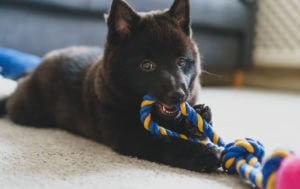How To Help a Teething Puppy
Congratulations on your new puppy! Chances are great that there are dozens of things you will know how to do right for your new furry family member — and often just the same number of things you will have no clue how to handle, even if this is far from your first puppy. Relax! It’s all part of the learning process. You and your dog are starting a remarkable journey together.
You will help your puppy through different phases in his or her life. One of the most important to you will be toilet training, but one of the most important to your puppy will be teething. Why? Because the teething period is quite uncomfortable, and your canine friend will look to you to provide relief. In the interest of educating yourself, let’s take a closer look at the puppy teething timeline, symptoms of teething, and what you can do to make your friend feel a bit better.
The Timeline…From Toothless to Mouthful
Puppies are born all gums. It takes only 2 to 4 weeks for their tiny teeth to start coming in. Your puppy will have about 28 teeth by the time it is 6 weeks old. At this point, mama is getting a bit tired of sharp teeth and starting to avoid feeding her brood. It’s also at this point that the breeder or shelter will be introducing soft puppy food to the litter.
Most breeders let their puppies go to new homes when they are 8 to 12 weeks old. It’s between 12 and 16 weeks (3 and 4 months) that you will start to find little baby teeth on your floors. You may be lucky enough to collect several for your collection of puppy firsts but you may find none. It’s not uncommon for puppy teeth to fall out during dinner time and get swallowed with the food.
By the time your new friend is 6 months old, all of his or her puppy teeth are expected to have fallen out. Born with 28 baby teeth ready to break through, your dog will have a complete set of 42 adult teeth when they all erupt.
If you notice that your puppy has a few baby teeth that refuse to fall out, notify your vet. It’s not all that uncommon for puppies to have one or two (sometimes more) stubborn deciduous teeth. Your vet will decide if there’s time to wait or if they need to be pulled.
Oh, My Aching Gums! Teething Symptoms
When infants are teething, they cry and get generally grouchy. When toddlers are teething, they are able to tell you that their mouth hurts. When young children have loose baby teeth, they proudly wiggle them with their chubby fingers. Your puppy’s symptoms may be a bit more subtle and can be mistakenly attributed to other issues.
A teething puppy may:
- Start chewing on things they didn’t chew on before
- Drool more often due to discomfort
- They may be slower or more reluctant to eat
- Whine about what seems like nothing
- Exhibit bleeding gums
- Have noticeably missing teeth
Please Help Me…What You Can Do For Your Furry Friend
The good news for your puppy’s comfort, and your sanity, is that there are quite a few things you can do to help your pup through the teething process.
1. Soft Food
You can help your puppy’s aching gums by providing soft food, or moist food, during the teething stage. You may choose to feed canned food, rehydrated food or even soak kibble in water. There’s really no trick to providing softer food — do what is convenient and suits your budget.
2. Appropriate Chew Toys
Give your little friend plenty of opportunities to chew on appropriate objects. Avoid hard nylon toys and antlers and, likewise, avoid extremely soft plush toys. Opt for toys made of rubber that have a slight give. One of the best brands of toys is KONG. The company makes a line of puppy toys specifically designed for active chewers shedding teeth.
3. Frozen Options
Few puppies will turn down a frozen toy or treat while teething. Put a puppy teething ring in the freezer, or stuff a treat-dispensing toy and freeze the food inside. Not only will your puppy have something to curb their desire to chew, but they will have a nice cold treat for their sore gums.
4. Remove Temptation
Chewing is a way that puppies explore since they don’t have fingers. After all, their mouth is the only thing your puppy has to grasp the world at large.
You don’t want to have to replace the things you’ve worked hard to buy just for a teething puppy to “investigate” them by tearing them apart, so puppy proof!
- Cords should be out of reach or covered
- Remote controls, eyeglasses, and cell phones should be too high to reach
- Anything toxic should be behind a closed door.
- You may want to invest in a baby gate or pen to keep your little one in a secure area while you are unable to closely monitor their behaviors.
Get Help Puppy Training and Getting Out Their Excess Energy
The family here at Greenlin Pet Resorts is passionate about all the creatures. We know how important it is to raise a puppy who will be well-adjusted and who has desirable behaviors. We offer a variety of services to enhance the life of your pet and provide some much-needed downtime for you, including puppy training and daycare, especially for puppies.
From puppy daycare to playtime, from obedience training to puppy boarding, we are here to help! Give us a call at any of our locations near you to have any of your questions answered or to schedule a service for your new family member.

